Review: Nauticam Wide Angle Corrector Port
HOW MUCH DIFFERENCE DO WATER CONTACT OPTICS MAKE?
The answer to this is it depends if they are good or not! Water contact optics have the potential to significantly outperform domes as Nikon showed with legendary lenses like the Nikonos 15 mm and Nikonos RS 13 mm. However, lenses are not easy to design and to be honest, the majority of lenses and ports that have been marketed as water contact down the years are not fully corrected and don’t outperform a correctly positioned dome. Caveat emptor.
For me, the Nauticam WWL-1 was a game changer in this regard and it is what started me haranguing Nauticam for an SLR version after my buddy Peter Rowlands took one of the first WWL-1s on our trip to California two years ago.
The WWL-1 is a wide angle wet lens, intended for Mirrorless and Compact cameras. Think of it as a little brother to the WACP! It is designed to work with a standard zoom behind a flat port and to convert this into a wide angle. In fact, not only is the front element corrected for being in water, so is the rear, and it also corrects for the problems introduced because the camera’s lens is looking out through a flat port immersed in water. As I mentioned above, not all wet lenses are created equal!
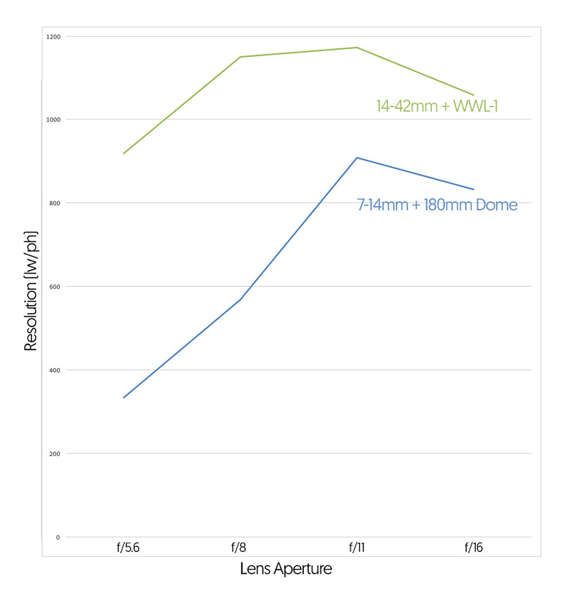
The graph, above, presents real data measured underwater in Nauticam’s optical testing facility (note that the axis are totally different to the previous graphs). The graph shows the amount of detail resolved by the camera close to the corner of the frame, across a range of apertures. The data is from a M43 camera with two different lens setups – Nauticam’s 180 dome and 7-14mm wide angle (the lens costs $1300, dome $500, seeing 114˚) and a 14-42mm kit lens (which costs just $300) and the Nauticam WWL-1 (which costs $1150, seeing 130˚).
Look at the 7-14mm and dome first, because the line reveals the classic problem of dome ports and the solution. At open apertures the resolution is low because of field curvature causes blurry corners, but closing the aperture helps considerably by bringing more of the virtual image into focus and therefore increasing the amount of detail resolved, peaking here at f/11. There is a small drop off in detail captured at f/16 because of diffraction (this is a 2x crop camera, on a full frame camera we could expect this line to be shifted a stop or so to the right because diffraction will come later).
The most obvious feature of the WWL-1 data is that despite giving a wider view (130˚ vs 114˚) it resolves more corner detail across the entire aperture range than the 7-14mm and dome do when performing at their best. Secondly, the WWL-1 data form a more horizontal line, with a lower loss of corner detail at more open apertures. This occurs because the water contact optics of the WWL-1 don’t have the same problems of field curvature as a dome. An important and perhaps surprising message here is that despite using a cheaper “kit” land lens, the superior correction provided by the WWL-1 results in significantly better underwater image quality than the expensive wide angle lens when used behind a dome.
Moving on to the big brother, the WACP has a major advantage over the WWL-1 – that it is not a removable wet lens, so corrections only have to be made at the front surface (not for the rear surface or the troublesome flat port of the camera) so it can be expected to significantly outperform the WWL-1. It also benefits from the knowledge that Nauticam learned developing the WWL-1. The downside is that now we are dealing with full frame, so everything must be much bigger! This is one of the reasons that the WACP is designed to work with relatively small lenses, because to work with big pro-lenses it would have to be huge, even more expensive and for all this the image quality gains would be minor (the bottleneck is the port, not the lens).
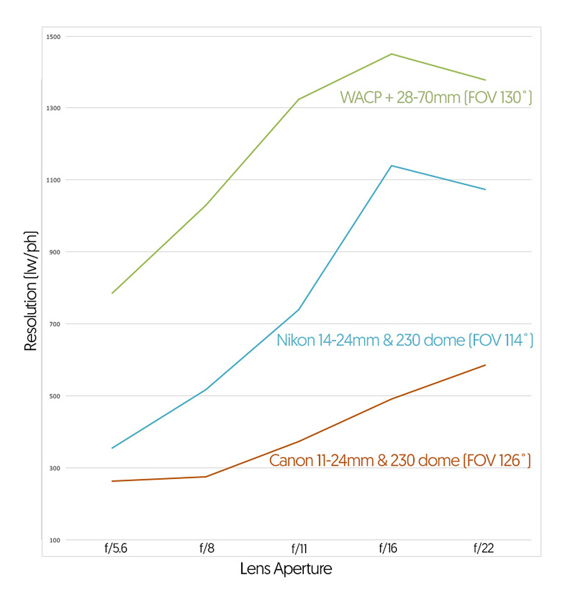
The graph presents real data measured underwater in Nauticam’s optical testing facility. The comparison is the same as with the WWL-1, further above, but note that the values on the axis are different. The Canon 11-24mm does not perform as well as Nikon 14-24mm, in the corners of the frame, primarily because it has such a wide field of view (126˚ versus 114˚). As a general rule, the wider a rectilinear lens the harder it is to get it to perform well behind a dome. It is also important to note that the WACP and 14-24mm were both tested on the same Nikon camera, while the Canon lens, understandably, was tested on a Canon camera. This might also account for the lower resolution recorded by the image analysis software.
The Nikon 14-24mm shows the classic pattern we would expect to see from a dome port, with increasing detailed resolved in the corners of the frame the more the aperture is closed (which brings the virtual image increasingly into focus). The highest detail was obtained at f/16, with a small drop at f/22, probably caused by diffraction. However, in the real world, a resolution above about 800 lw/ph (it stands for line widths resolved in the picture height, but I wouldn’t get too caught up in it) in the corner of the frame would look decent, which the 14-24mm achieves at about f/13.
The WACP and the Nikon 28-70mm outperforms the Nikon 14-24mm significantly at all apertures, despite its much greater FOV (130˚ versus 114˚). Furthermore, the WACP resolves greater than 800 lw/ph at all apertures tested. The graph also shows that the WACP produces approximately the same corner sharpness as the 14-24mm when the aperture is at least 2 stops (that is 6 clicks on most cameras) more open. This is equivalent of being able to shoot at f/5.6, rather than f/11 or f/13. Note that these data represent is best case for the 14-24mm, as it was tested here with a large dome, optimum port extension and with the aperture closed down.
I’ll save you from another graph, but the same tests in the center of the frame demonstrate that the WACP setup also resolves more detail relative to the pro-quality wide angle zooms. Although the difference is smaller than in the corners (because there isn’t the field curvature effect) and the advantage over the 14-24mm is about 1 stop in the center.
In conclusion, the optical tank tests show that the WACP with the 28-70mm significantly outperforms dome ports across the range of apertures and produces useable corner resolution right across the range of apertures from f/5.6 to f/22.
CORNER SHARPNESS TESTS IN THE OCEAN
As we have seen on the previous page, the limitations of domes are not really in the center of the frame, but towards the corners, and the wider the lens views the worse it gets. These problems can be greatly reduced by using the largest dome ports (correctly positioned) and stopping the aperture down. However, having to always shoot at apertures closed to f/11-f/16 can be a limitation (particularly in getting strobes to illuminate a large scene). The tank tests show that the WACP can produce highly acceptable image quality in the corners of the frame, across a wide range of apertures. Now to test it in the ocean! Yes, it is time for the obligatory corner sharpness shots!
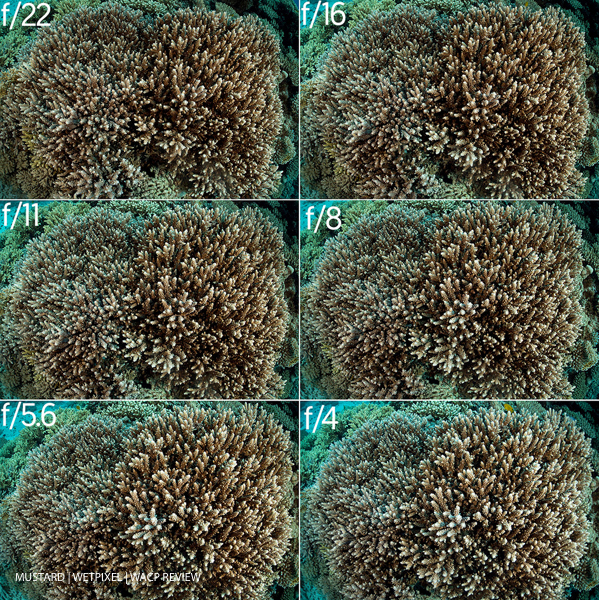
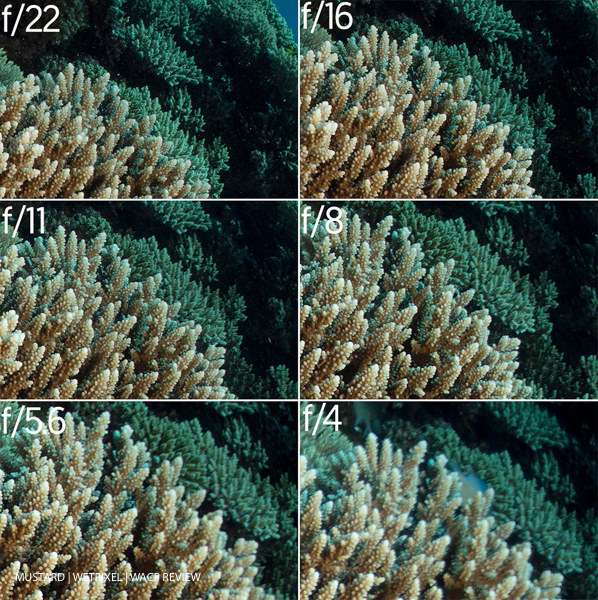
Test images of this nature are more demanding of corner sharpness, than a classically composed wide angle shot, which tends to have a subject in the center of the frame and open water or more distant subject matter in the corners. The test series of images above show that the WACP does not have the optical problems of domes, which would show large areas blurred towards the corners of the frame. There is excellent corner detail from f/8 to f/22 and even when the lens is more open than this is remains entirely useable, although some detail is lost simply because of the limited depth of field. Even an aperture of f/5.6 would give excellent results with most wide angle compositions and f/4 would give very good results when shooting pelagics against open water backgrounds (where there isn’t important detail in the corners anyway.)
To put these results in context, below are a similar series of shots taken with the same camera, housing and strobes, but using a 16-35mm lens and 230 mm dome port (on the same trip, but not same dive!) I also used Sea & Sea’s correction lens on my 16-35mm, which is reported to give up to 1 stop improvement in corner sharpness — so these tests are a best case example. Indeed I have already sold photos taken with this setup from this very dive, so the setup is clearly capable of professional quality. Again, I should stress that shooting flat subject matter, with detail into the corners of the frame is more demanding than our typical wide angle compositions. However, you should also note that the 16-35mm with the Sea & Sea correction lens (which reduces the FOV by about 5%) has a field of view of 102˚, significantly 28˚ less than the WACP.
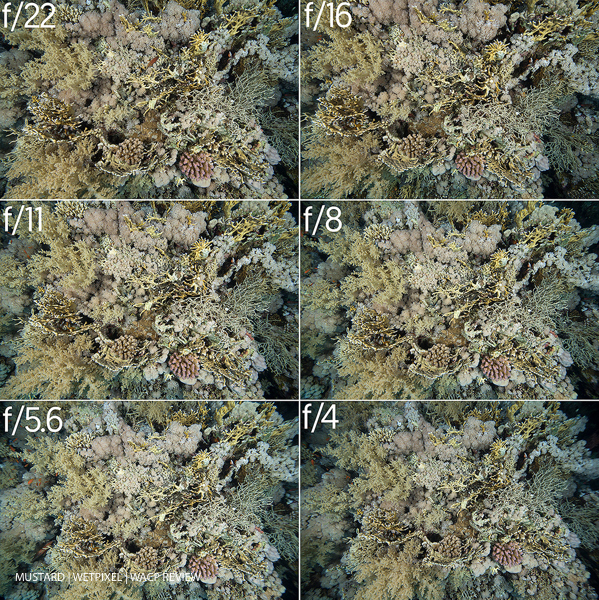
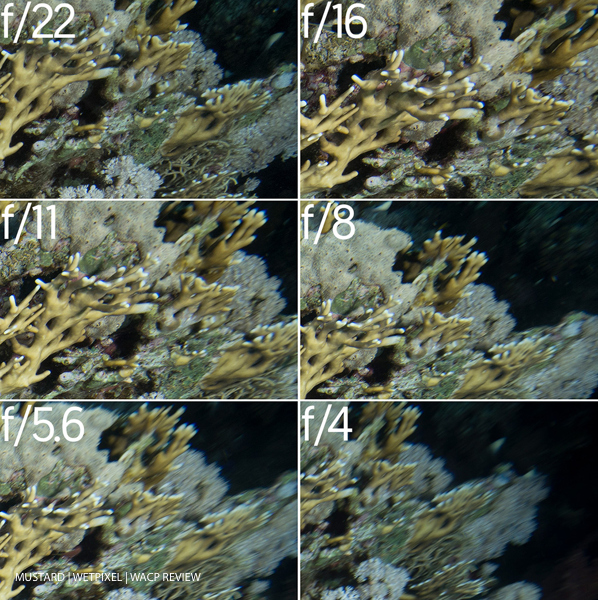
These results demonstrate show what we would expect when shooting with a dome, with increasing loss of detail in the corners of the frame as the aperture is open. The best corner image quality comes at f/16 and f/22. However f/11, definitely, and f/8, with compromise, should be entirely useable in more normal wide angle compositions where there corners are likely to be dark or open water.
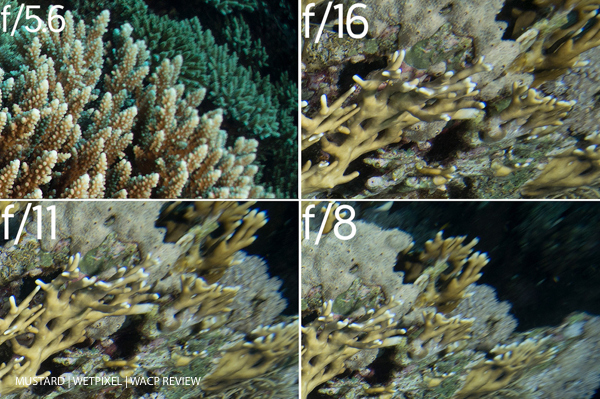
The fun comparison above suggests that the WACP not only sees much wider than the 16-35mm (and if zoomed in to the same field of view as the 16-35mm would perform even better), but gives up to a 3 stop advantage in respect to corner detail. However, it is important to note that the difference between the two, is much less at closed apertures – at f/16 both give high quality corners. This is because the corner image quality of the 16-35mm behind the dome improves greatly as the aperture is closed. That said, there is no doubt that the WACP offers new capabilities for full frame photographers and videographers as a wide angle zoom lens.
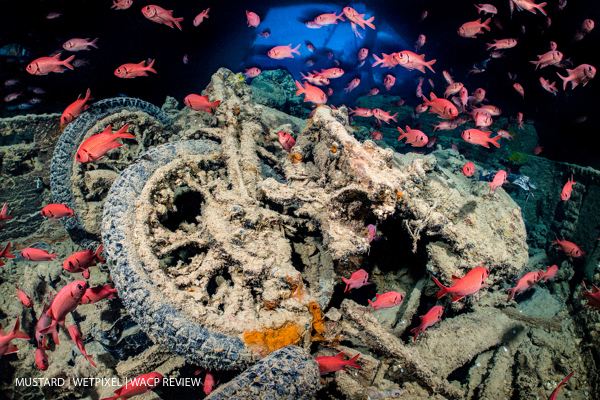
Page 1: Underwater optics issues and the WACP.
Page 2: How optics work underwater and dome ports.
Page 3: Water contact lens advantages and image results.
Page 4: Jason Isley’s comments, ocean images and conclusion.